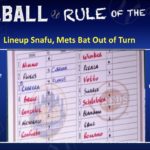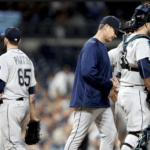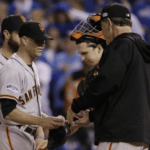Rule 3 – Section 1 – SUBSTITUTING
3-1-1 After the umpire has received the official lineup card prior to the game, the player listed as pitcher shall pitch until the first opposing batter has been put out or has advanced to first base. In any other case, a substitute may replace a player of his team when the ball is dead and time has been called. The umpire-in-chief shall record any reported substitutions on the lineup card and then announce immediately any change(s) to the opposing team. Projected substitutions are not allowed. In each of the following situations, the ball is declared live by the umpire-in-chief. Should there be no announcement of substitutions, a substitute has entered the game when the ball is live and:
- a runner takes the place of a runner he has replaced,
- a pitcher takes his place on the pitcher’s plate,
- a fielder reaches the position usually occupied by the fielder he has replaced, or
- a batter takes his place in the batter’s box.
PENALTY: If the starting pitcher does not face one batter, he may play another position, but not return to pitch.
For discovery of an illegal player (2-36-3) on offense by an umpire or either team, that player shall be called out and restricted to the bench/dugout for the duration of the game. An illegal player discovered on defense shall be restricted to the bench/dugout for the duration of the game. If a restricted player re-enters the game on offense, he shall be called out immediately and ejected upon discovery by an umpire or either team. If he is a defensive player, he shall be ejected upon discovery by an umpire or either team.
The penalty for illegal substitution shall supersede the penalty for batting out of order.
If the player should score a run, advance or cause a play to be made that allows another runner(s) to advance, discovery must be made by an umpire or either team before the first pitch to the next batter of either team. This would invalidate the action of the illegal offensive player. Any out(s) made on the play stands and all other runners return to the base(s) occupied at the time of the pitch.
In a game-ending situation, discovery must be made before all infielders leave the diamond (i.e., all infielders cross the foul lines).
An illegal player on defense shall be replaced immediately upon discovery by the umpire or either team. If an illegal player on defense is involved in a play, and the infraction is discovered by an umpire or either team prior to the first pitch to the next batter of either team, the team on offense has the option to let the play stand or to allow the batter to bat again.
Any player for whom an illegal player substitutes may re-enter only if he is eligible to do so under the re-entry rule (3-1-3).
3-1-2 If a pitcher is replaced while his team is on defense, the substitute pitcher shall pitch to the batter then at bat, or any substitute for that batter, until such batter is put out or reaches first base, or until a third out has been made. To ensure that the requirements of this article be fulfilled, the umpire will deny any coach-defensive player conference that will violate the rule. If a pitcher is incapacitated or guilty of flagrant unsportsmanlike conduct, this rule is ignored. A player may be removed as pitcher and returned as pitcher only once per inning, provided the return as pitcher does not violate either the pitching, substitution or charged conference rule. If the pitcher, because of an injury or being incapacitated, is replaced as pitcher and the above rule is not satisfied, or if his replacement requires more warm-up throws than permitted in 6-2-2 Exception, he cannot return to the game as a pitcher.
3-1-3 Any of the starting players may be withdrawn and re-entered once, including a player who was the designated hitter, provided such player occupies the same batting position whenever he is in the lineup. The pitcher is governed by the provisions of Article 3-1-2 above. A substitute who is withdrawn may not re-enter. A starting pitcher who is replaced in the top of the first inning while his team is at bat shall be governed by the provisions of Articles 3-1-1 and 3-1-2 above.
3-1-4 Designated Hitter (DH) can be used in two ways. The DH can be listed as the tenth starter replacing one of the other nine players when it is their turn to bat. The other method is that that any one of the starting defensive players can be their own DH (in effect having two positions) within the confines of the rule requirements.
3-1-5 Any player who exhibits signs, symptoms or behaviors consistent with a concussion (such as loss of consciousness, headache, dizziness, confusion or balance problems) shall be immediately removed from the game and shall not return to play until cleared by an appropriate health-care professional. (See NFHS Suggested Guidelines for Management of Concussions)
3-1-6 A player or coach who is bleeding or who has an open wound shall be prohibited from participating further in the game until appropriate treatment has been administered. If medical care or treatment can be administered in a reasonable amount of time, the individual would not have to leave the game. The length of time that is considered reasonable is umpire judgment. The re-entry rule applies to starters. If there is an excessive amount of blood on the uniform, it shall be changed before that individual participates again. (See Communicable Disease Procedures)





